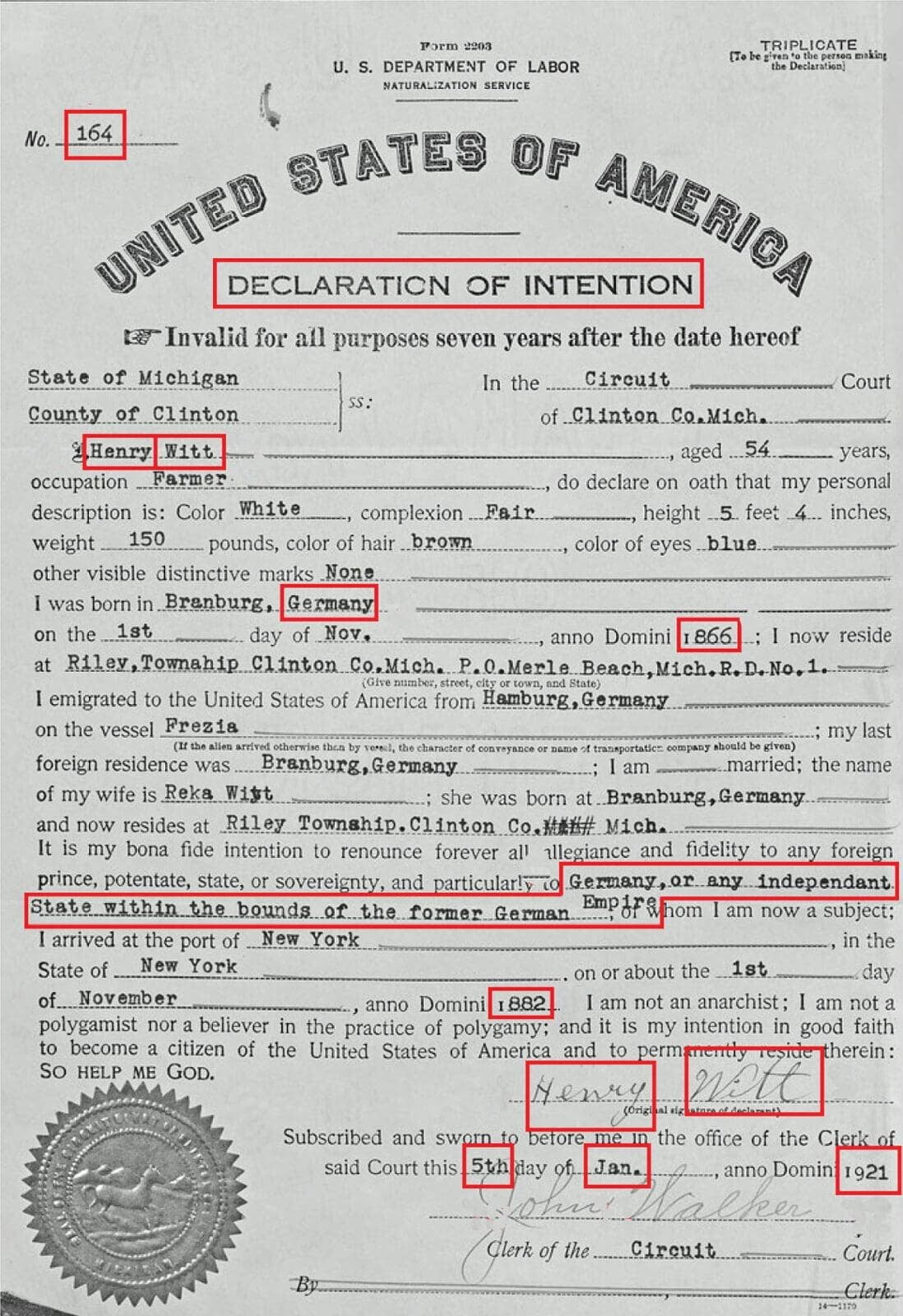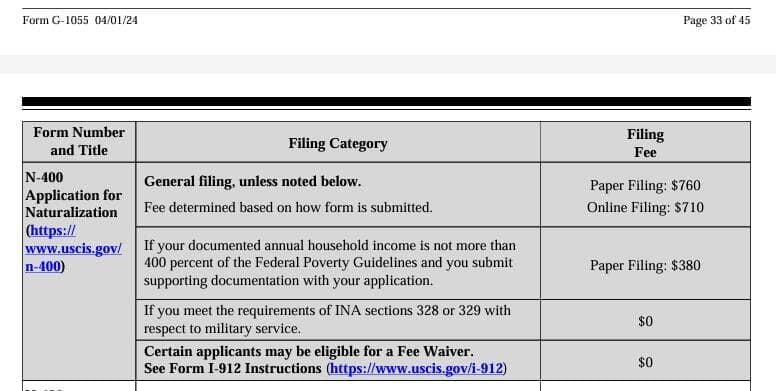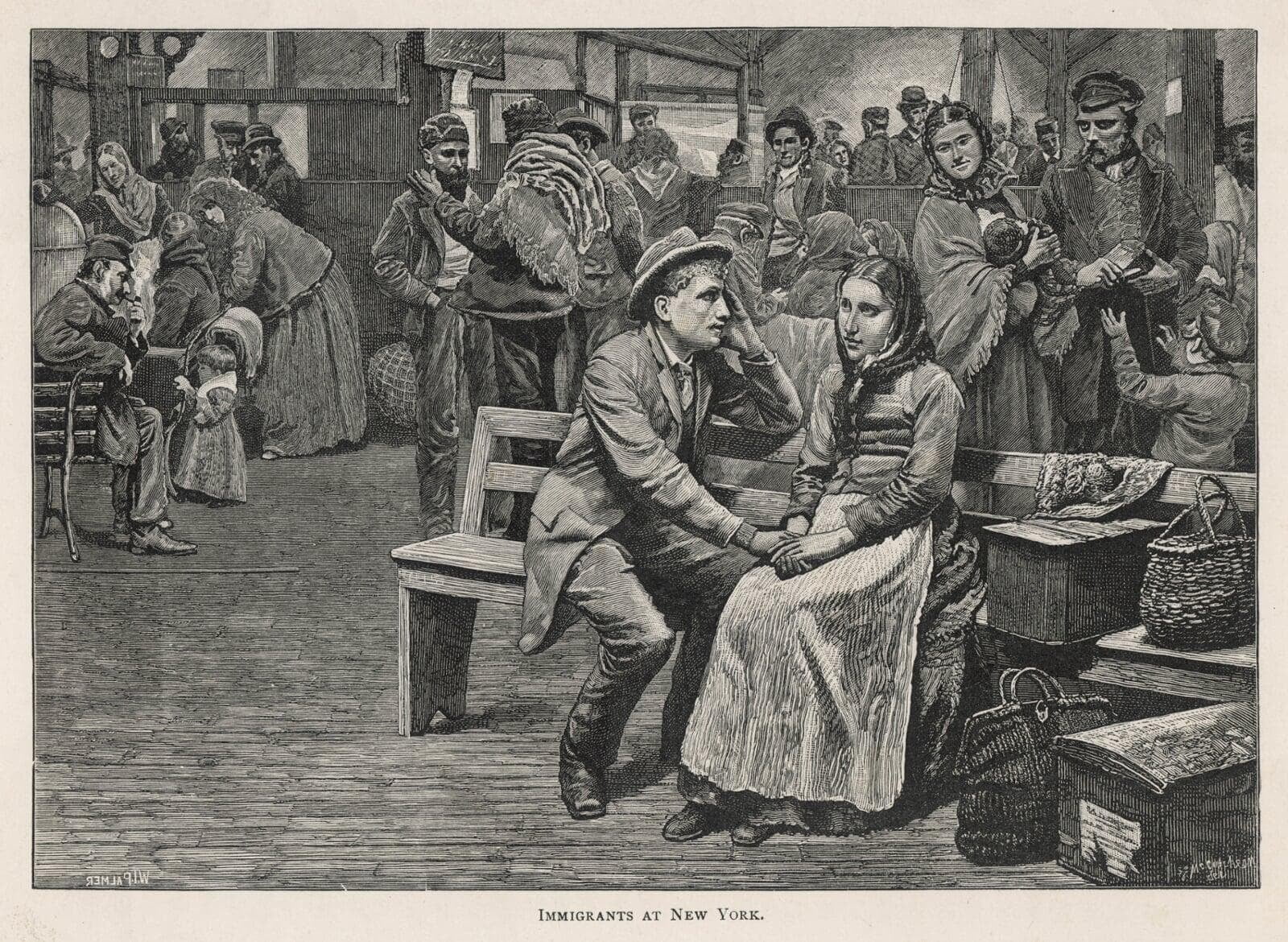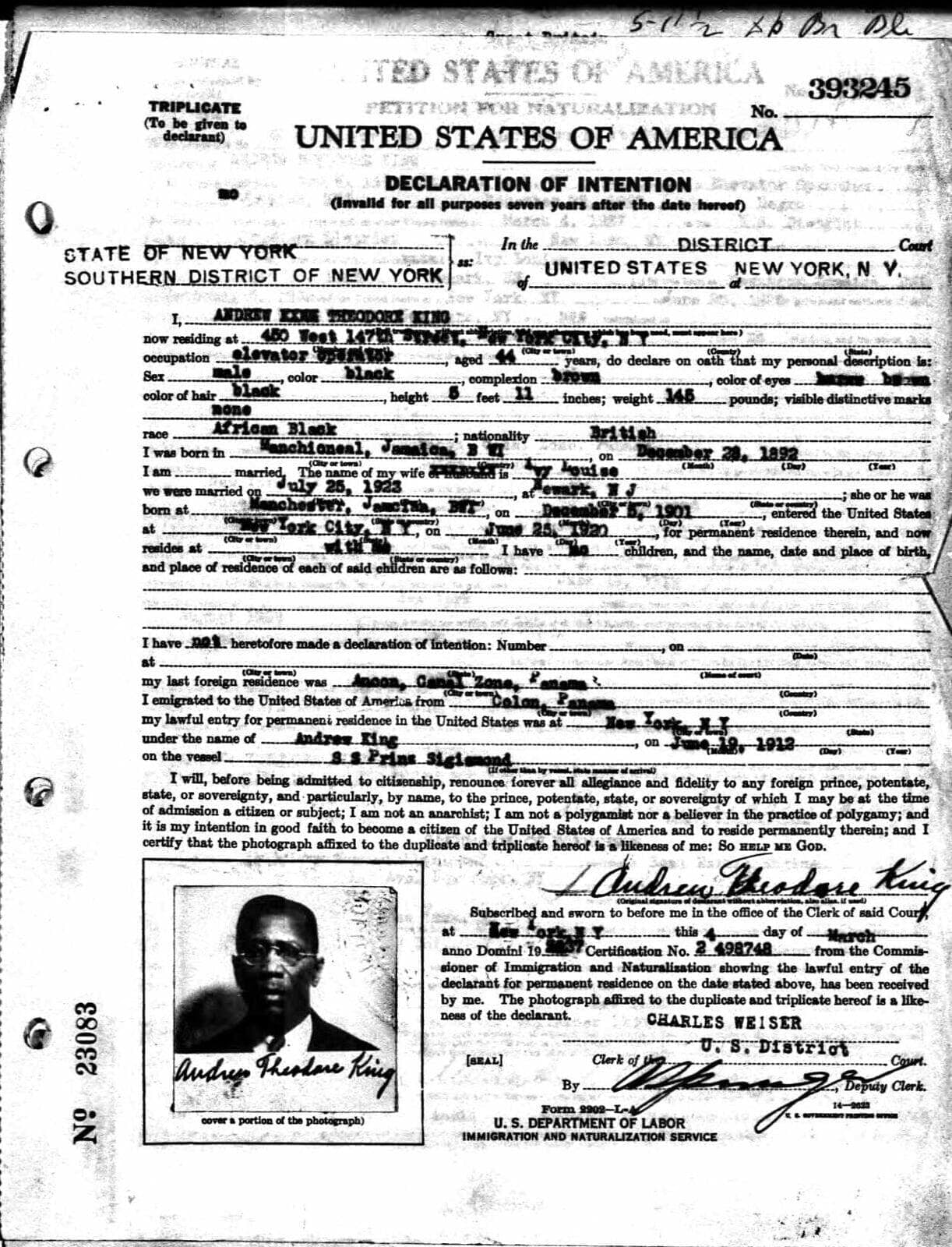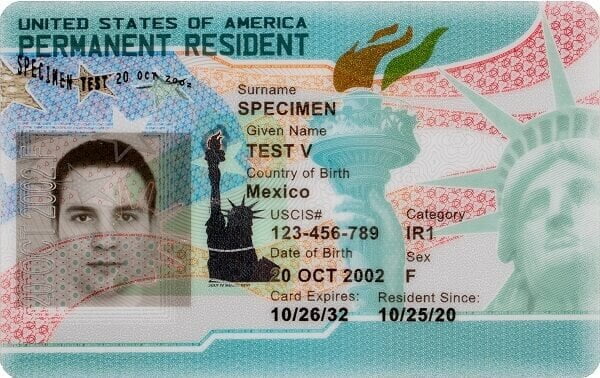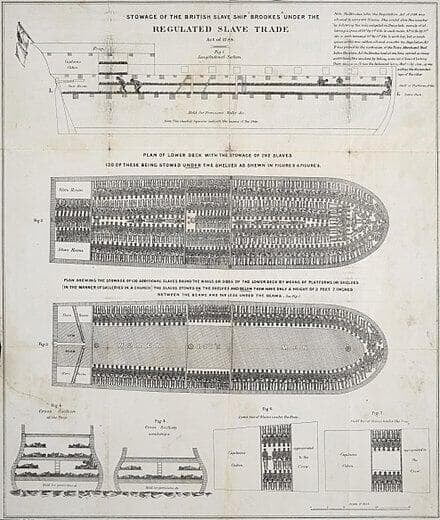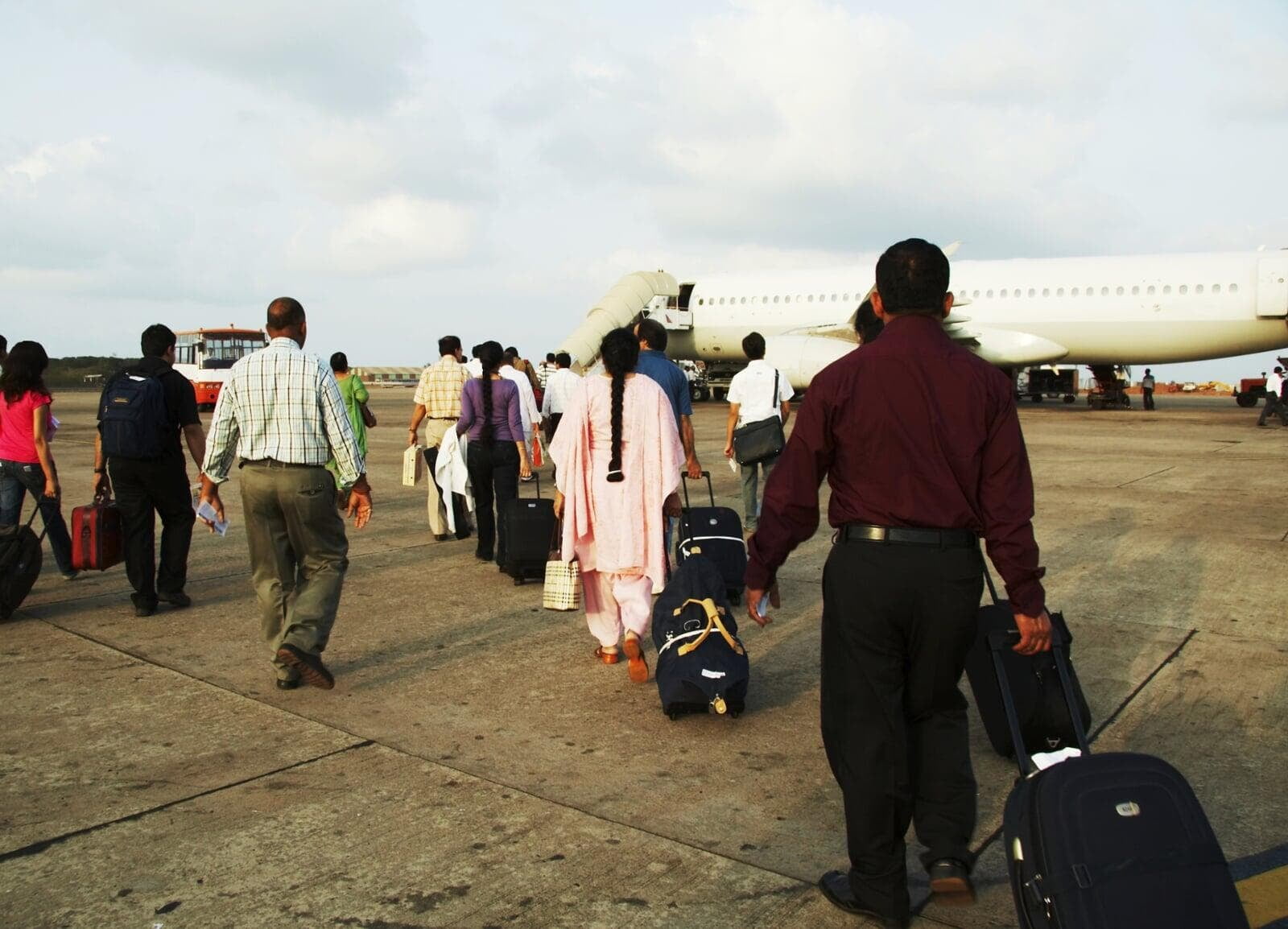LET US assist YOU in your first
Actio-step towards becoming U.S. Naturalized
LET US PREPARe YOUR FORM N-400

You input your information here -- through our N-400 Online Module. We will use your data to prepare your official Form N-400. This will be filled out on the latest, (April 1, 2024), USCIS version of the N-400.
We'll provide you with two (2) prepared copies; one Form to Submit to USCIS and one Form for your personal records. We'll also provide with a compiled list of the documents required to submit along with your Form. This list is based upon your given responses.
You can edit text on your website by double clicking on a text box on your website. Alternatively, when you select a text box a settings menu will appear. your website by double clicking on a text box on your website. Alternatively, when you select a text box.
The Latest Edition of Form N-400 dated 04-01-2024
Form N-400, Application for Naturalization, is an application to become a naturalized U.S. citizen.
What Is the Purpose of Form N-400?If your biological or legal adoptive mother or father is a U.S. citizen by birth, or was naturalized before you reached your 18th birthday, you may already be a U.S. citizen.
If either of your parents is a United States citizen, complete Part 6. Information About Your Parents as part of this application.
If neither of your parents is a United States citizen, skip Part 6. and complete Part 7. Biographical Information.
List of General Eligibility Requirements
In general, you may apply for naturalization when you meet all the requirements to become a U.S. citizen. The following general eligibility requirements apply to most naturalization applicants (for more information about each of these requirements and exceptions, see the Specific Instructions by Item Number below):
1. You are at least 18 years of age when you file.2. You have been a lawful permanent resident of the United States for at least 5 years;3. You have demonstrated continuous residence in the United States for at least 5 years;
4. You have lived in the U.S. state or U.S. Citizenship and Immigration Services (USCIS) district where you claim residence for at least 3 months before filing;
5. You have demonstrated physical presence in the United States for at least 30 months (913 days);6. You demonstrate good moral character.
7. You demonstrate an attachment to the principles of the U.S. Constitution;8. You demonstrate a basic knowledge of U.S. history and government (also known as “civics”) as well as an ability to read, write, speak, and understand basic English; and
9. You are willing to take the Oath of Allegiance to the United States, and you are well disposed to the good order and happiness of the United States.
Also see the Naturalization Eligibility Tool, available athttps://www.uscis.gov/citizenship-resource-center/learn-about-citizenship/naturalization-eligibility.
Early Filing
If you are applying based on lawful permanent residence for 5 years, you may generally file your application up to 90 days before meeting the required 5-year period of continuous residence as a lawful permanent resident. If you are applying based on your marriage to a U.S. citizen, you may generally file up to 90 days before meeting the required 3-year period of continuous residence as a lawful permanent resident.However, applicants filing up to 90 days before meeting the continuous residence requirement must still meet all other requirements for naturalization at the time of filing Form N-400. If these requirements are not met at the 90-day period, the applicant must wait to file until the requirement is met, otherwise, the application will be rejected or denied. For example:1. If you are applying under the Immigration and Nationality Act (INA) section 319(a) as the spouse of a U.S. citizen, you must have been married to a U.S. citizen for at least 3 years at the time you file Form N-400. See the Eligibility Based on Marriage to a U.S. Citizen section in the Specific Instructions by Item Number, Part 5., Item Numbers5.a. - 5.b. section of these Instructions for information on applying as the spouse of a U.S. citizen; or2.If you request an exception to the English testing requirements, you must meet the requirements for the exception(age and years as a lawful permanent resident) when you file Form N-400. See the Naturalization Testing and Exceptions section in the Specific Instructions by Item Number, Part 2., Item Number 11. of these Instructions for more information about exceptions to the English testing requirements.You can use the USCIS Early Filing Calculator to ensure that you file your Form N-400 no earlier than 90 days before you complete the required period. Visit the USCIS website at www.uscis.gov/early-filing-calculator. We will reject your application if you submit it too early.
Signature
You (or your signing authority) must properly complete your application. USCIS will not accept a stamped or typewritten name in place of any signature on this application. If you are under 14 years of age, your parent or legal guardian may sign the application on your behalf. A legal guardian, surrogate, or designated representative may sign for a person who is unable to understand or communicate an understanding of the Oath of Allegiance because of a physical or developmental disability or mental impairment. If your application is not signed, or if the signature is not valid, we will reject your application. See 8 CFR 103.2(a)(7)(ii)(A). If USCIS accepts a request for adjudication and determines that it has a deficient signature, USCIS will deny the request.
Validity of Signatures. USCIS will consider a photocopied, faxed, or scanned copy of an original, handwritten signature as valid for filing purposes. The photocopy, fax, or scan must be of the original document containing the handwritten ink signature. You can edit text on your website by double clicking on a text box on your website. Alternatively, when you select a text box a settings menu will appear. your website by double clicking on a text box on your website. Alternatively, when you select a text box
Filing Fee
See Form G-1055, available at www.uscis.gov/forms, for specific information about the fees applicable to this form.
The table below presents the fees, effective April 1, 2024, for all U.S. Citizenship and Immigration Services (USCIS) forms. Each application, petition, or request must be accompanied by the correct fee(s) unless you are exempt from paying the fee(s) or are eligible for a fee waiver. If the fee is incorrect, the application, petition, or request will be rejected.
Filing Online You may file certain forms online as indicated in the table below. If you file your form online (see www.uscis.gov/file-online), the system will guide you through the process of paying your fees with a credit, debit, or pre-paid card. Bank account withdrawals are also available when paying online.
Filing by Mail If you are filing your application or petition by mail, please visit our website for filing guidance, at www.uscis.gov/forms/filing-guidance/form-filing-tips.
Fees for applications or petitions can be paid by check or credit card: 1) 2) Payments by Checks or Money Orders. You may pay fees with bank drafts, cashier's checks, certified checks, personal checks, and money orders that are drawn on U.S. financial institutions and payable in U.S. funds. Make the check or money order payable to U.S. Department of Homeland Security, do not use the initials “USDHS” or “DHS.” Generally, you must mail your check or money order together with your application or petition. Use a separate check or money order for each application or petition you submit. Do not combine the filing fees for multiple applications or petitions into one check or money order. NOTE: If you send USCIS a check, we will convert it into an electronic funds transfer (EFT). This means we will copy your check and use the account information on it to electronically debit your account for the amount of the check. The debit from your account will usually take 24 hours and your bank will show it on your regular account statement. You will not receive your original check back. We will destroy your original check but will keep a copy of it. If USCIS cannot process the EFT for technical reasons, you authorize us to process the copy in place of your original check. If your check is returned as unpayable, we may reject your application, petition, or request. Payments by Credit Card. You may pay your fee(s), using a credit card. Please see Form G-1450 (http://www.uscis.gov/g-1450), Authorization for Credit Card Transactions, for more information. Filing at a USCIS Office If you are filing your application or petition at a USCIS office, cash, a cashier's check, or money order cannot be used to pay for the filing and/or biometric services fee. The only payment options accepted at a USCIS office are payment through pay.gov via a credit card, debit card, or with a personal check. Fee Waivers Certain filers may qualify for a fee waiver for certain forms. See Form I-912, Request for Fee Waiver, at www.uscis.gov/i-912 to determine if you are eligible for a fee waiver. If you are not eligible for a fee waiver, you must submit the correct fee(s). Page 1 of 4
Evidence
When you file your application, you must submit all evidence and supporting documents at the time of filing; however, USCIS may accept evidence you provide at your interview. See each part of the Specific Instructions by Item Number for the specific evidence required.
Biometric Service Appointment
USCIS may require you to appear for an interview and provide biometrics(fingerprints, photograph, and/or signature) at any time to verify your identity, obtain additional information, and conduct background and security checks, including a check of criminal history records maintained by the Federal Bureau of Investigation (FBI), before making a decision on your application or petition. If we determine that a biometric services appointment is necessary, we will send you an appointment notice with the date, time, and location of your appointment. If you are currently overseas, your notice will instruct you to contact a U.S. Embassy, U.S. Consulate, or USCIS office outside the United States to set up an appointment.
At your biometrics appointment, you must sign an oath reaffirming that:1.You provided or authorized all information in the application;2.You reviewed and understood all of the information contained in, and submitted with, your application; and
3.All of this information was complete, true, and correct at the time of filing.
If you do not attend your biometric services appointment, we may deny your application.
Photograph Requirements for Applicants Residing Outside the United States
Certain applicants for naturalization may be eligible for naturalization even though they reside outside the United States, including current members of the U.S. armed forces, their spouses, former members of the U.S. armed forces who served during a designated period of hostilities, and spouses of U.S. citizens working for a qualified employer outside the United States. If you are applying from outside the United States because you are in one of those categories, you must submit two identical color passport-style photographs of yourself taken recently.
The photos must have a white to off-white background, be printed on thin paper with a glossy finish, and be unmounted and unretouched. The photos must be 2 by 2 inches with a full face, frontal view. Head height should measure 1 to 1 3/8 inches from the top of your hair to the bottom of your chin, and eye height should measure between 1 1/8 and 1 3/8 inches from the top of your eyes to the bottom of the photo. Your head must be bare unless you are wearing headwear required by your religious denomination. Using a pencil or felt pen to lightly print your name and A-Number (if any) on the back of the photos.
Copies
Copies. You should submit legible photocopies of requested documents unless the Instructions specifically instruct you to submit an original document. USCIS may request an original document at any time during our process. If we request an original document from you, we will return it to you after USCIS determines it no longer needs the original.
NOTE: If you submit original documents when they are not required or requested, USCIS may destroy them after we receive them.
Translations
If you submit a document with information in a foreign language, you must also submit a full English translation. The translator must sign a certification that the English language translation is complete and accurate, and that they are competent to translate from the foreign language into English. The certification must also include their signature, printed name, the signature date, and their contact information.
USCIS Contact Center
USCIS Contact Center. For additional information on the application and Instructions about where to file, change of address, and other questions, visit the USCIS Contact Center at www.uscis.gov/contactcenter or call 800-375-5283 (TTY 800-767-1833). The USCIS Contact Center provides information in English and Spanish.
Disability Accommodation/Modification
Disability Accommodations / Modifications. To request a disability accommodation / modification, follow the instructions on your appointment notice or at www.uscis.gov/accommodationsinfo.
How To Complete Form N-400
1. Type or print legibly in black ink.2. If you need extra space to complete any item within this application, use the space provided in Part 14. Additional Information. Type or print your name and A-Number (if any), at the top of each sheet; indicate the Page Number, Part Number, and Item Number to which your answer refers; and sign and date each sheet.3. Answer all questions fully and accurately. If a question does not apply to you (for example, if you have never been married and the question asks “Provide the name of your current spouse”), type or print “N/A” unless otherwise directed. If your answer to a question that requires a numeric response is zero or none (for example, “How many children do you have” or “How many times have you departed the United States”), type or print “None” unless otherwise directed.4. Avoid highlighting, crossing out, or typing or printing outside the area provided for a response. If you must make substantial corrections to your Form N-400, USCIS recommends that you start a new Form N-400 rather than using correction tape or fluid to correct the information. Our scanners may see through the white correction tape or fluid. This may lead to incorrect information being captured in our systems, which may cause processing delays or a rejection of your Form N-400.5. Provide your A-Number (if any), on the top right corner of each page. Your A-Number is located on your Permanent Resident Card (Green Card, formerly known as the Alien Registration Card). The A-Number on your card consists of a seven- to nine-digit number, depending on when your record was created. If the A-Number on your card has fewer than nine digits, place enough zeros before the first number to make a total of nine digits on Form N-400. For example, type or print number A1234567 as A001234567 or type or print number A12345678 as A012345678. TheA-Number may be located on the front or back of your card, depending on when the card was issued.6. Your application must be properly completed, signed, and filed. You must include all pages when you file FormN-400, even if the pages are blank. A photocopy of the original application is acceptable as long as all signatures on the application are handwritten. USCIS will not accept a stamped or typewritten name in place of a signature.
PART 1: INFORMATION ABOUT YOUR ELIGIBILITY
PART 1: INFORMATION ABOUT YOUR ELIGIBILITY
Select only one box.
Item Numbers 1.A. - 1.G.
Select the box of naturalization eligibility that applies to you. Select only one box to identify your eligibility. If you select more than one box or if you do not select any boxes, your Form N-400 may be delayed or rejected.
1.A. General Provision.
Select this box if you have been a lawful permanent resident (LPR) of the United States for at least 5 years.
1.B. Spouse of U.S. Citizen.
Select this box if you seek to naturalize based on your marriage to a U.S. citizen. Generally, to qualify for naturalization based on marriage to a U.S. citizen, you must have been a lawful permanent resident for at least 3 years. For more information see Specific Instructions by Item Number, Part 5., Item Numbers 5.a. - 5.b.
1.C. VAWA.
Select this box if you are a person who obtained LPR status as the spouse or child of a U.S. citizen who was subjected to battery or extreme cruelty and seek to naturalize under the spousal provision without having to live in marital union for at least 3 years. For more information see Specific Instructions by Item Number, Part 5., Item Numbers 5.a. - 5.b.
1.D. Spouse of U.S. Citizen in Qualified Employment Outside the United States.
Select this box if you seek to naturalize based on your U.S. citizen spouse working for a qualified employer outside the United States (INA section 319(b)). For more information see Specific Instructions by Item Number, Part 5., Item Number 8.
If your residential address is outside the United States and you are filing under this option, select the USCIS field office where you would like to have your naturalization interview. You can find your USCIS district at www.uscis.gov/field-offices.
1.E. Military Service during Period of Hostilities.
Select this box if you seek to naturalize based on honorable service in active duty or in the Selected Reserve of the Ready Reserve of the U.S. armed forces during a designated period of hostilities. If you were in the United States or certain other specified areas at the time of enlistment, reenlistment, extension of enlistment, or induction, you may apply for naturalization without LPR status. See Eligibility and Evidence for Current and Former Members of the U.S. Armed Forces in Specific Instructions by Item Number, Part 9., Item Numbers 23. - 29. for more information of hostilities. If you were in the United States or certain other specified areas at the time of enlistment, reenlistment, extension of enlistment, or induction, you may apply for naturalization without LPR status. See Eligibility and Evidence for Current and Former Members of the U.S. Armed Forces in Specific Instructions by Item Number, Part 9., Item Numbers 23. - 29. for more information.
1.F. At Least One Year of Honorable Military Service at Any Time.
Select this box if you seek to naturalize based on at least 1 year of honorable service in the U.S. armed forces at any time. See Eligibility and Evidence for Current and Former Members of the U.S. Armed Forces in Specific Instructions by Item Number, Part 9., Item Numbers 23. - 29. for more information.
Part 2. Information About You (Person Applying For Naturalization)
Item Number 1.Your Current Legal Name (do not provide a nickname). Your current legal name is the name on your birth certificate unless it changed after birth by a marriage, divorce, or court order.Required Evidence - Name ChangeProvide documentation if your name changed - for example, marriage certificate, divorce decree, or court order.Item Number 2.Other Names You Have Used Since Birth. Provide all other names you have ever used, including aliases, maiden name, family name at birth, assumed names, nicknames, and alternate spellings or variations of names. Include any names used in previous immigration applications, petitions, or removal proceedings; any names provided to immigration officers, U.S. Customs and Border Protection, or U.S. Immigration and Customs Enforcement; and any names used in any Federal, state, or local criminal arrests, citations, or proceedings. Include the first, middle, and last name for each additional name used. If you need extra space to complete this section, use the space provided in Part 14. Additional Information.Item Number 3.Name Change (Optional). A court can allow you to change your name when you naturalize. Any name change you request on this application will not be final until you are naturalized by the court. If you want the court to change your name at your naturalization ceremony, select “Yes” and provide the requested information to complete this section. You do not need to request a name change if your legal name has already changed through marriage, divorce, or other court order.We cannot process name change requests for members of the military, or their spouses, who are seeking naturalization outside of the United States.Item Number 4.USCIS Online Account Number (if any). You will only have a USCIS Online Account Number(OAN ) if you previously filed a form that has a receipt number that begins with IOE. If you filed the form online, you can find your OAN in your account profile. If you mailed us the form, you can find your OAN at the top of the Account Access Notice we sent you. If you do not have a receipt number that begins with IOE, you do not have an OAN. The OAN is not the same as an A-Number.Item Number 5.Gender. Indicate how you identify. Based on your selection, a gender of “M” (male), “F” (female) or “X” (another gender identity) will be reflected on your secure documents if your application is approved.Item Number 6.Date of Birth (mm/dd/yyyy). In addition to providing your actual date of birth, include any other dates of birth you have ever used, including dates used in connection with any legal names or non-legal names in the space provided in Part 14. Additional Information. Provide your date of birth in this order: Month, Day, Year. Use eight numbers to show your date of birth in the mm/dd/yyyy format. We will reject your Form N-400 if you do not provide your date of birth.Item Number 7.Date You Became a Lawful Permanent Resident. If you are a lawful permanent resident, provide the official date when your permanent residence began, as shown on your Permanent Resident Card (Green Card, formerly known as the Alien Registration Card). Provide the date in this order: Month, Day, Year. Use eight numbers to show the date you became a lawful permanent resident in the mm/dd/yyyy format. We may reject your application if you are a lawful permanent resident and do not provide the date you became a lawful permanent resident.We need both your A-Number (USCIS Number) and your permanent resident date (if applicable) to process your application. Where applicable, if you do not have this information, you should contact the USCIS Contact Center at www.uscis.gov/contactcenter to obtain this information before you file your Form N-400.Lawful Admission for Permanent ResidenceIn general, you must show that you have been lawfully admitted to the United States for permanent residence in accordance with all applicable provisions of the Immigration and Nationality Act (INA) in effect at the time of your admission or adjustment. This requirement applies to your initial admission as a lawful permanent resident (LPR) or adjustment to LPR status, as well as all subsequent reentries into the United States.In addition, you must show that you have not abandoned your LPR status. If you leave the United States and demonstrate you no longer intend to reside in the United States, that is abandoning LPR status.Time as a Lawful Permanent ResidentIn general, you must be a lawful permanent resident for 5 years before applying for naturalization unless you are:•A U.S. noncitizen national (person born in American Samoa or Swains Island) (not required to be a lawful permanent resident);•Applying for naturalization based on service in the U.S. armed forces (see the Specific Instructions by Item Number, Part 9., Item Numbers 23. - 29. in these Instructions for more information);•Applying for naturalization based on being a spouse of a U.S. citizen (see the Specific Instructions by Item Number, Part 5., Item Numbers 5.a. - 5.b. in these Instructions for more information), including the spouse of a U.S. citizen in qualified employment outside the United States (see the Specific Instructions by Item Number, Part 5., Item Number 8. in these Instructions for more information); or•Applying for naturalization under the Violence Against Women Act (VAWA) based on being a spouse or child of a U.S. citizen who battered you or subjected you to extreme cruelty (see the Specific Instructions by Item Number, Part 5., Item Numbers 5.a. - 5.b. in these Instructions for more information).Conditional Permanent ResidentsIf you are a conditional permanent resident, you must file Form I-751, Petition to Remove Conditions on Residence,or Form I-829, Petition by Investor to Remove Conditions on Permanent Resident Status, within 90 days before your conditional permanent resident status expires, unless you can establish good cause and extenuating circumstances for failing to file Form I-751 or Form I-829 during that time period. In most cases, you must have an approved Form I-751 or Form I-829 before we can approve your application for naturalization.Military members applying under INA section 329 and certain spouses of U.S. citizens employed outside the United States by qualified organizations under INA section 319(b) do not need an approved Form I-751 or Form I-829.Item Number 8.Country of Birth. Type or print the name of the country in which you were born. Use the name of the country at the time of your birth, even if the name of the country has changed.Item Number 9.Country of Citizenship or Nationality. Type or print the current name of the country of which you are currently a citizen or national. If the country’s name has changed, type or print the current name of the country. If you are stateless, type or print the name of the country, as it currently exists, where you were last a citizen or national. If you are a citizen or national of more than one country, type or print the name of the foreign country that issued your last passport in this Item Number. Provide information about additional countries of citizenship or nationality using Part 14. Additional Information.Item Number 11.Disability Exceptions to Testing. Select “Yes” if you are requesting an exception to the English language test or civics test or both based on a physical or developmental disability or mental impairment that prevents you from complying with the English language or civics requirements for naturalization.Naturalization Testing and ExceptionsAlmost all applicants for naturalization must take a naturalization test to demonstrate that they are able to read, write, speak, and understand English, and that they have a basic knowledge of civics (U.S. history and government). You do not have to take the English reading, writing, speaking, and understanding test, and you can take the civics test in a language of your choice if at the time you file your application:•You are 50 years of age or older and have been a lawful permanent resident for at least 20 years; or•You are age 55 years of age or older and have been a lawful permanent resident for at least 15 years.If you are 65 years of age or older and have been a lawful permanent resident for at least 20 years, you may take a simplified version of the civics test. For additional information about the test, please visit www.uscis.gov/citizenship.You may be eligible for an exception to the English language test or civics test or both if you have a physical or developmental disability or mental impairment that has lasted, or is expected to last, 12 months or more. If you are requesting a medical exception to the English language and civics tests, answer “Yes” to Part 2., Item Number 11. in Form N-400 and submit a completed Form N-648, Medical Certification for Disability Exceptions (available at www.uscis.gov/N-648) with your Form N-400.If you need an interpreter and you qualify for an exception to the English part of the test, you must bring an interpreter to the interview. For additional information on who may qualify as an interpreter, see Policy Manual Volume 12, Citizenship and Naturalization, Part B, Naturalization Examination, Chapter 3, Naturalization Interview (available at www.uscis.gov/policy-manual/volume-12-part-b-chapter-3).Required Evidence - Disability ExceptionsIf you answer “Yes” to Part 2., Item Number 11., you must provide a completed Form N-648, Medical Certification for Disability Exceptions (available at www.uscis.gov/N-648) when you file your Form N-400. Submitting Form N-648 does not guarantee we will exempt you from the testing requirements.Legal Guardian, Surrogate, or Designated RepresentativeIf you cannot undergo any part of the naturalization process because of a physical or developmental disability or mental impairment, you may have a legal guardian, a surrogate, or an eligible designated representative complete the naturalization process for you.Required Evidence - Legal Guardian, Surrogate, or Designated Representative1.Provide a court order authorizing the legal guardian or surrogate to exercise authority over the applicant’s affairs. In the absence of a court ordered legal guardian or surrogate, an authorized designated representative who is the primary custodial caregiver and who takes responsibility for the applicant can serve as the designated representative. The family member must provide documentation to establish a familial relationship between the applicant and the designated representative, as well as proof that the designated representative is the primary custodial caregiver and takes responsibility for the applicant.2.If unable to take the Oath, you may provide a completed and signed Form N-648, Medical Certification for Disability Exceptions. Alternatively, you may provide a written evaluation by an authorized medical professional.Item Numbers 12.a. - 12.c.Social Security Update.If you want the Social Security Administration (SSA) to issue you an original Social Security card or issue a replacement Social Security card and update your immigration status, then answer “Yes” to both Item Numbers 12.a. and 12.c., which gives your consent for USCIS to provide your information to the SSA. If you want a replacement card, you must enter the SSN from your card in Item Number 12.b. If you provide your Consent for Disclosure in Item Number 12.c., then if USCIS approves your application and you take the Oath of Allegiance, we will provide information from your application and USCIS systems, including your immigration status, to the SSA. The SSA may assign you an SSN and issue you an original or replacement Social Security card. The SSA will also update your immigration status to that of U.S. citizen after you take the Oath of Allegiance.If you request a name change as part of Form N-400, USCIS will send your updated name to the SSA.You are not required to request a Social Security card using this application. However, you must have a Social Security Number (SSN) properly assigned in your name to work in the United States.If your employer uses E-Verify to confirm new employees’ eligibility to legally work in the United States, the information you provide on Form I-9, Employment Eligibility Verification, will be compared to data in SSA and Department of Homeland Security (DHS) databases. Employees must have an SSN in order for E-Verify to confirm their eligibility to legally work in the United States. For information about privacy, see the Social Security Administration Privacy Act Statement in the DHS Privacy Notice section of the Instructions.
Part 3. Biographic Information
Provide the biographic information requested in Item Numbers 1. - 6. of this part. Providing this information as part of your application may reduce the time you spend at your USCIS ASC appointment as described in the Biometric Services Appointment section of the General Instructions for Filing Form N-400.Item Numbers 1. - 2.
Ethnicity and Race. Select the boxes that best describe your ethnicity and race. Categories and Definitions for Ethnicity and Race
1. Hispanic or Latino. A person of Cuban, Mexican, Puerto Rican, South or Central American, or other Spanish culture or origin, regardless of race. (NOTE: This category is only included under Ethnicity in Part 3., Item Number 1.)2. American Indian or Alaska Native. A person having origins in any of the original peoples of North and South America (including Central America), and who maintains tribal affiliation or community attachment.3. Asian. A person having origins in any of the original peoples of the Far East, Southeast Asia, or the Indian subcontinent including, for example, Cambodia, China, India, Japan, Korea, Malaysia, Pakistan, the Philippine Islands, Thailand, and Vietnam.4. Black or African American. A person having origins in any of the black racial groups of Africa.5. Native Hawaiian or Other Pacific Islander. A person having origins in any of the original peoples of Hawaii, Guam, Samoa, or other Pacific Islands.6. White. A person having origins in any of the original peoples of Europe, the Middle East, or North Africa.Item Number 3.Height.Item Number 4.Select the values that best match your height in feet and inches.For example, if you are five feet and nine inches, select “5” for feet and “09” for inches. Do not enter your height in meters or centimeters.Weight.Item Number 5.Enter your weight in pounds. If you do not know your weight or need to enter a weight under 30 pounds or over 699 pounds, enter “000.” Do not enter your weight in kilograms.Eye Color. Select the box that best describes the color of your eyes.Item Number 6.Hair Color. Select the box that best describes the color of your hair
Part 4: Information About Your Residence
Based in part on the information you provide in this Part 4. Information About Your Residence, Part 7. Information About Your Employment and Schools You Attended, and Part 8. Time Outside the United States of Form N-400, USCIS will determine whether you meet the requirements for continuous residence, physical presence, and 3-month residency in a USCIS district or U.S. state.In Part 4., list every location where you have lived during the last 5 years if you are filing based on general provision, under Item Number 1.A. in Part 1. Information About Your Eligibility.
- If you are filing as the spouse of a U.S. citizen, under Item Number 1.B. in Part 1.
- Information About Your Eligibility, list every location where you have lived during the last 3 years.
- If you are filing as the spouse of a U.S. citizen, under Item Number 1.B. in Part 1. Information About Your Eligibility, list every location where you have lived during the last 3 years.
- If you are filing as the spouse, former spouse, or child of a U.S. citizen under the Violence Against Women Act
- (VAWA), under Item Number 1.C. in Part 1. Information About Your Eligibility, list every location where you have lived during the last 3 years.
- If you are filing as the spouse of a U.S. citizen in qualified employment outside the United States, under Item Number 1.D. in Part 1. Information About Your Eligibility, you do not have to list every location where you have lived, only the current location.
- If you are filing based on military service during a period of hostilities, under Item Number 1.E. in Part 1. Information About Your Eligibility, you do not have to list every location where you have lived, only the current location.
- If you are filing based on at least one year of honorable military service at any time, under Item Number 1.F. in Part 1.Information About Your Eligibility, list every location where you have lived during the last 5 years.
- If you are filing based on another reason for filing not listed above, under Item Number 1.G. in Part 1. Information About Your Eligibility, list every location where you have lived during the last 5 years.
Item Number 1. Physical AddressesYou must provide a physical address so that USCIS can schedule your biometric and interview appointments at the correct location.If you are currently homelessyou can indicate “homeless” in the Physical Address field; however, you will need to provide the city or town, state, ZIP code, and province and country (if you live outside the United States) where you live. You can then use Form G-1145, e-Notification of Application/Petition Acceptance, to request notification by text or email confirming receipt of your Form N-400.If you are a victim of domestic violence,you are not required to disclose the confidential address of a shelter or safe house. If you are currently residing in a shelter or safe house or have resided in a shelter or safe house for part of the reporting period, you may provide just the name of the city and state of residence for the shelter or safe house in Part 4., Item Number 1. If we need further clarification, we will ask at the interview.Item Numbers 2. and 3. Mailing AddressIf your mailing address is not the same as your current physical address or if you did not provide a complete physical address, you must provide a current mailing address. We will use your mailing address to mail notices. If you do not provide a current, complete, and valid mailing address, we may reject your Form N-400.If you are residing in a shelter or safe house at the time of filing this application or you otherwise do not feel safe providing your current mailing address, you may provide a “safe address” where you are able to receive mail in Part 4., Item Number 3. You may provide a post office box (P.O. Box) or the address of a friend, your attorney, a community-based organization that is helping you, or any other address where you can safely and timely receive mail.If you reside outside of the United States, are applying under INA section 319(b), and you want us to collect your biometrics in the United States, you must provide an address in the United States. We will send a letter to your U.S. mailing address notifying you when and where to go for your biometric services appointment
Part 5. Information About Your Marital History
See the Eligibility Based on Marriage to a U.S. Citizen section in the Specific Instructions section of these Instructions.Item Number 1.Current Marital Status. Select the box that best describes your marital status.Item Number 2.Military Spouses. Select “Yes,” if your spouse is a current member of the U.S. armed forces or “No,” if your spouse is not a current member of the U.S. armed forces.Eligibility and Evidence for the Spouse of a Member of the U.S. Armed ForcesIf you are the lawful permanent resident spouse of a member of the U.S. armed forces, you are authorized to accompany the member and reside abroad with them under their official orders, and you are residing outside the United States with them in marital union, you may be eligible to complete the entire naturalization process outside the United States. Provide the following evidence:1. Documentation you are authorized to accompany the member under their official orders; and2. Documentation of their military service with the U.S. armed forces.
Item Number 3.Marriages. Your response should include your current marriage, any marriages before or during your current marriage, marriages in the United States, marriages in other countries, annulled marriages, civil marriages, and customary or religious marriages, whether or not the marriage was registered with a government. If you have been married more than once to the same person, count each marriage separately. Type or print the number of times you have been married.Item Numbers 4.a. - 4.d.
Enter the legal name, date of birth, date of marriage of your current spouse, and whether your spouse’s physical address is the same as your physical address.
Item Numbers 5.a. - 5.b.
Enter when your current spouse became a U.S. citizen.
In addition to the general eligibility requirements listed above, you must meet certain requirements if you seek to naturalize based on your marriage to a U.S. citizen. If you or your spouse were previously married, you must demonstrate that all of your and your spouse’s previous marriages were lawfully terminated. Please see Part 5. Information About Your Marital History of Form N-400 for what information we require about your marital history.
Generally, to qualify for naturalization based on marriage to a U.S. citizen, you must meet these requirements at the time you file your application:
1. You must be legally married to a U.S. citizen who resides in the United States, and you must remain legally married to the U.S. citizen until you take the Oath of Allegiance.
2. You must have been living in marital union with your U.S. citizen spouse for at least 3 years;
3. Your spouse must have been a U.S. citizen for at least 3 years; and
4. You must have been a lawful permanent resident for at least 3 years (see the Early Filing section of these Instructions for additional information).
Required Evidence - Eligibility Based on Marriage to a U.S. Citizen
Provide a copy of the following if you are applying for naturalization based on your marriage to a U.S. citizen:
1. Evidence that your spouse has been a U.S. citizen for at least 3 years at the time you file your Form N-400. For example:
A. Your spouse’s U.S. birth certificate (if your spouse has held U.S. citizenship since birth);
B. Your spouse’s Certificate of Naturalization.
C. Your spouse’s Certificate of Citizenship
D. Your spouse’s Form FS-240, Consular Report of Birth Abroad; or
E. The biographical page of your spouse’s U.S. passport;
2. Current marriage certificate and any divorce decree, annulment decree, or death certificate showing that your and your spouse’s prior marriages were terminated (if applicable); and
3. Evidence that you and your spouse have lived in marital union for at least 3 years before the time you file your Form N-400. Some examples include:
A. Joint bank or credit card statements.
B. Leases or mortgages.
C. Birth certificates or adoption decrees (as applicable) for any children born or adopted during the marriage by either spouse.
D. Insurance policies; and
E. IRS tax transcripts for you and your spouse for the past 3 years.
Eligibility for the Spouse, Former Spouse, or Child of a U.S. Citizen under the Violence Against Women Act (VAWA)
Any person who obtained LPR status as the spouse or child of a U.S. citizen who subjected the person to battery or extreme cruelty may naturalize under the spousal provision without having to live in marital union for at least 3 years. To qualify you must:
1. Have obtained LPR status based on:
• An approved Petition for Amerasian, Widow(er), or Special Immigrant (www.uscis.gov/i-360) as the self-petitioning spouse, intended spouse, or child of an abusive U.S. citizen.
• An approved Petition for Amerasian, Widow(er), or Special Immigrant (www.uscis.gov/i-360) as the self-petitioning spouse, intended spouse, or child of an abusive LPR, if the abusive spouse naturalizes after the petition has been approved.
• Special rule cancellation of removal for abused spouses and children in cases where the applicant was the child, spouse, or intended spouse of a U.S. citizen, who subjected them to battery or extreme cruelty.
• An approved Petition for Amerasian, Widow(er), or Special Immigrant (www.uscis.gov/i-360) as the derivative child of a self-petitioning spouse of a U.S. citizen who was battered or subjected to extreme cruelty by a U.S. citizen spouse; or
• An approved Petition to Remove Conditions on Residence (www.uscis.gov/i-751), for a conditional permanent resident, filed as a waiver of the joint filing requirement, if the marriage was entered into in good faith and the spouse, intended spouse, or child was subjected to battery or extreme cruelty by the petitioning citizen spouse or parent.
2. Be at least 18 years of age.
3. Continuously reside in the United States for at least 3 years after obtaining lawful permanent residence.
4. Be physically present in the United States for at least 18 months during the 3 years immediately before filing your application.
5. Live in the state or USCIS district with jurisdiction over your place of residence for at least 3 months before filing your application; and
6. Demonstrate good moral character for at least 3 years before filing your application.
NOTE: Evidence of the spouse's U.S. citizenship, marriage to the U.S. citizen, divorce or separation, or marital union is NOT required if you obtained LPR status as the spouse, former spouse, or intended spouse of a U.S. citizen who subjected you to battery or extreme cruelty.
Item Number 7.
Spouse’s Marriages. Your response should include your spouse’s current marriage, any marriages before or during your spouse’s current marriage, marriages in the United States, marriages in other countries, annulled marriages, civil marriages, and customary or religious marriages whether or not the marriage was registered with a government.
Item Number 8.
Current Spouse’s Current Employer or Company. Answer this question only if you are filing as a spouse of a U.S. citizen in qualified employment outside the United States.
Eligibility for the Spouse of a U.S. Citizen Working for a Qualified Employer Outside the United States
In addition to some of the general eligibility requirements listed above, you must meet certain requirements if you seek to naturalize based on your U.S. citizen spouse working for a qualified
employer outside the United States (INA section 319(b)).
1. You must be legally married to a U.S. citizen who is working outside the United States for a qualified employer.
2. Your U.S. citizen spouse’s qualified employment outside the United States must be scheduled to last for at least 1 year after the time you file Form N-400.
3. You must be a lawful permanent resident when you file your application for naturalization.
4. You must declare in good faith an intention to reside in the United States immediately after your spouse’s qualified employment outside the United States ends.
5. You must be present in the United States when you take the Oath of Allegiance; and
6. You must establish that you will join your U.S. citizen spouse within 30 to 45 days after you are naturalized.
If you meet these requirements, you are not required to show any prior residence or period of physical presence within the United States or any state or USCIS district. You must be present in the United States at the time of your interview and naturalization. In Part 1. Information About Your Eligibility of Form N-400, type or print the name of the USCIS field office where you would like to have your naturalization interview or select a USCIS field office from the drop-down menu. Visit the USCIS website at www.uscis.gov/field-offices to find a USCIS field office.
For a list of qualifying employers, see Item C. in Item Number 3. below.
Required Evidence - Eligibility for the Spouse of a U.S. Citizen Working for a Qualified Employer Outside the United States
1. Evidence that your spouse is a U.S. citizen at the time you file your Form N-400. For examples, see Required Evidence - Eligibility Based on Marriage to a U.S. Citizen in the Specific Instructions by Item Number, Part 5., Item Numbers 5.a. - 5.b. section of the Instructions.
2. Current marriage certificate and any divorce decree, annulment decree, or death certificate showing that your and your spouse’s prior marriages were terminated (if applicable); and
3. Evidence demonstrating your U.S. citizen spouse’s qualified employment outside the United States. For example:
A. The employer’s name and nature of the employer’s business.
B. The nature of the work the U.S. citizen spouse is performing; and
C. Documentation to establish the employing entity is:
(1) The U.S. Government.
(2) An American institution of research recognized as such by the Attorney General (see www.uscis.gov/air).
(3) A public international organization in which the United States participates by treaty or statute.
(4) An American firm or corporation that is engaged in whole or in part in the development of U.S. foreign trade and commerce; or
(5) A religious denomination or an interdenominational mission organization and your spouse is performing the ministerial or priestly functions of the religious denomination or is serving as a missionary, brother, nun, or sister for the religious denomination or interdenominational mission.
D. In addition, provide the following:
(1) If applicable, your U.S. citizen spouse’s travel orders which include your name.
(2) Documentation to establish your spouse’s qualified employment outside the United States is scheduled to last for at least 1 year from the date you file Form N-400; and
(3) A typed or printed statement of your intent to reside outside the United States with your spouse and to live in the United States immediately after your spouse’s qualified employment outside the United States ends.
Part 6. Information About Your Children
Indicate your total number of children under 18 years of age. You must indicate ALL children under 18 years of age, including: children born in the United States or in other countries; children living with you or elsewhere; current stepchildren; legally adopted children; missing children; and children born when you were not married, when you were in a civil marriage (whether or not the child’s other parent was your spouse), or when you were in a customary or religious marriage (whether or not the child’s other parent was your spouse).An applicant who willfully failed or refused to support his or her dependents during the statutory period, even if there is no court-ordered child support, cannot establish good moral character (GMC) unless the applicant establishes extenuating circumstances.Required Evidence - Child and Spousal SupportProvide evidence that you have complied with any child and spousal support obligations. If you have dependent children living apart from you, provide evidence that you support each dependent child and that you have complied with any child support obligations. If a court has ordered you to provide financial support for a spouse, former spouse, or children, provide the court or government order and evidence that you have complied with the order. For example:1.Cancelled checks or money order receipts;2.A court or agency document showing child support payments;3.Evidence of wage garnishments; or4.A notarized letter from the parent or guardian who cares for your children.
Part 7. Information About Your Employment and Schools You Attended
In Parts 7. and 8.You will provide more information about your continuous residence and physical presence in the United States for the required period.In Part 7.List where you have worked or attended school full time or part time during the last 5 years in the table provided if you are filing based on general provision, under Item Number 1.A. in Part 1. Information About Your Eligibility.•If you are filing as the spouse of a U.S. citizen, under Item Number 1.B. in Part 1. Information About Your Eligibility, list where you have worked or attended school full time or part time during the last 3 years.•If you are filing as the spouse, former spouse, or child of a U.S. citizen under the Violence Against Women Act(VAWA), under Item Number 1.C. in Part 1. Information About Your Eligibility, list where you have worked or attended school full time or part time during the last 3 years.•If you are filing as the spouse of a U.S. citizen in qualified employment outside the United States, under Item Number 1.D. in Part 1. Information About Your Eligibility, list where you have worked or attended school full time or part time during the last 3 years.•If you are filing based on military service during a period of hostilities, under Item Number 1.E. in Part 1. Information About Your Eligibility list where you have worked or attended school full time or part time during the last year.•If you are filing based on at least one year of honorable military service at any time, under Item Number 1.F. in Part1.Information About Your Eligibility, list where you have worked or attended school full time or part time during the last 5 years.•If you are filing based on another reason for filing not listed above, under Item Number 1.G. in Part 1. Information About Your Eligibility, list where you have worked or attended school full time or part time during the last 5 years.
Part 8. Time Outside the United States
In Part 8.
list all the trips that you have taken outside the United States during the last 5 years if you are filing based on general provision, under Item Number 1.A. in Part 1. Information About Your Eligibility.
•If you are filing as the spouse of a U.S. citizen, under Item Number 1.B. in Part 1. Information About Your Eligibility, list all the trips that you have taken outside the United States during the last 3 years.
•If you are filing as the spouse, former spouse, or child of a U.S. citizen under the Violence Against Women Act
(VAWA), under Item Number 1.C. in Part 1. Information About Your Eligibility, list all the trips that you have taken outside the United States during the last 3 years.
•If you are filing as the spouse of a U.S. citizen in qualified employment outside the United States, under Item Number 1.D. in Part 1. Information About Your Eligibility, you do not have to list any trips that you have taken outside the United States.
•If you are filing based on military service during a period of hostilities, under Item Number 1.E. in Part 1. Information About Your Eligibility, you do not have to list any trips that you have taken outside the United States.
•If you are filing based on at least one year of honorable military service at any time, under Item Number 1.F. in Part
1.Information About Your Eligibility, list all the trips that you have taken outside the United States during the last 5 years.
•If you are filing based on another reason for filing not listed above, under Item Number 1.G. in Part 1. Information About Your Eligibility, list all the trips that you have taken outside the United States during the last 5 years.
Continuous Residence
If you are required to demonstrate lawful permanent residence, you must establish that you did not break the continuity of your residence in the United States. You can see what information we require about your travel in Part 8. Time Outside the United States.
“Continuous residence” means that you have not been outside the United States for a long period of time. Generally:
1.If you are applying based on being a lawful permanent resident, the continuous residence requirement is at least 5 years; or
2.If you are applying based on being a spouse to a U.S. citizen, or if you are applying based on obtaining status as a lawful permanent resident as the spouse or child of a U.S. citizen who battered you or subjected you to extreme cruelty (INA section 319(a)), the continuous residence requirement is at least 3 years.
To establish continuous residence in the United States, you must demonstrate that you have maintained your residence in the United States for the entire time within the 3- or 5-year period.
The USCIS officer will review your travel history and documents during your naturalization interview to determine if you meet this requirement. You will not meet the continuous residence requirement if you left the United States, without our approval, for a continuous period of 1 year or more during your required continuous residence period or after you filed your Form N-400. (See the Preserving Continuous Residence table and the Preserving Residence Through Form N-470 section below.)
If you were absent for more than 6 months but less than 1 year, you must demonstrate that you did not break the continuity of your residence in the United States.
Some factors indicating that you did not break the continuity of your residence are:
1.You did not terminate your employment in the United States or work while outside the United States;
2.Your immediate family remained in the United States during your absence; or
3.You retained full access to your home residence in the United States.
Residence in the Commonwealth of the Northern Mariana Islands on or after November 28, 2009, is considered continuous residence within the United States for naturalization purposes.
Required Evidence - Continuous Residence
If you have taken any trips outside the United States that lasted more than 6 months but less than 1 year, provide evidence that you maintained your continuous residence in the United States. For example:
1.Internal Revenue Service (IRS) tax transcripts listing tax information relevant to your absence for the last 5 years (or 3 years if you are applying on the basis of marriage to a U.S. citizen);
2.Rent or mortgage statements, or pay statements;
3.Bank, credit card, or loan statements showing regular transactions;
4.Proof of car registration and insurance;
5.Your passport showing entry and exit stamps; or
6.Any other document that shows that you maintained your residence in the United States.
The Preserving Continuous Residence table below lists some common circumstances under which you may be eligible to count time residing outside the U.S. as residence in the United States for naturalization purposes.
Preserving Continuous Residence
NOTE: Approval and use of a Reentry Permit or Refugee Travel Document for extended absences does not preserve continuous residence for naturalization purposes.
Preserving Residence Through Form N-470
If you were absent for 1 year or more during the period when continuous residence is required while working in qualified employment outside the United States, you generally must have an approved Form N-470, Application to Preserve Residence for Naturalization Purposes, to preserve your continuous residence. For additional information, see the Form N-470 Instructions at www.uscis.gov/N-470.
3-Month Residency in a USCIS District or U.S. State
In general, you must have resided in the same USCIS district or the same U.S. state for at least 3 months before filing Form N-400. Please refer to Part 4. Information About Your Residence of Form N-400 for what information we require about your address history.
You can find your USCIS district at www.uscis.gov/field-offices.
Residence of Students
Lawful permanent resident students who are eligible for naturalization may apply for naturalization either in the USCIS district where they go to school or in the USCIS district where their parents live if they are still financially dependent on their parents.
Physical Presence
Certain applicants must meet physical presence requirements in the United States. Physical presence refers to the number of days you must be physically present in the United States during the period of continuous residence required before you file Form N-400.
In general, you must have been physically present in the United States for a period or periods totaling at least half of the required continuous residence period. We will count the day that you depart from the United States and the day you return as days of physical presence within the United States for naturalization purposes.
The table below lists some common bases of eligibility for naturalization, and if applicable, how long a person eligible under those provisions must have been present in the United States. Please refer to Part 8. Time Outside the United States of Form N-400 regarding what information we require about your travel history.
Physical Presence Requirements
In Part 8.
list all the trips that you have taken outside the United States during the last 5 years if you are filing based on general provision, under Item Number 1.A. in Part 1. Information About Your Eligibility.
•If you are filing as the spouse of a U.S. citizen, under Item Number 1.B. in Part 1. Information About Your Eligibility, list all the trips that you have taken outside the United States during the last 3 years.
Part 9. Additional Information About YouYour answers to the questions in this Part of Form N-400 will help to determine whether you meet the standards for good moral character. Some of the questions in this Part also relate to national security, your attachment to the principles of the U.S. Constitution, and other requirements for naturalization.Good Moral CharacterGood Moral Character (GMC) means character that measures up to the standards of average citizens of the community in which the applicant resides. In general, an applicant must show that they have been and continue to be a person of GMC during the required period (for example, 5 years if you are applying based on 5 years as a lawful permanent resident or 3 years if you are applying as the spouse of a U.S. citizen) prior to filing and up to the time of the Oath of Allegiance.Item Numbers 1. - 2. You may not qualify for naturalization if you previously claimed you were a U.S. citizen or you unlawfully voted in the United States in a Federal, state, or local election. However, voting in a local election will not render an applicant ineligible for naturalization if the applicant was eligible to vote under the relevant law.Item Numbers 3. - 4. If you have failed to pay taxes as required, we may determine that you lack good moral character. See www.irs.gov to determine whether you were required to file a tax return.Required Evidence - TaxesTax transcripts are not required for every case. If you have any Federal, state, or local taxes that are overdue, provide:
1.IRS tax transcripts for the past 5 years, or 3 years if filing for naturalization on the basis of marriage to a U.S. citizen;
2.A signed agreement from the IRS or state or local tax office showing you have filed a tax return and have arranged to pay the taxes you owe; and
3.Documentation from the IRS or state or local tax office showing the current status of your repayment program.NOTE: Go to www.irs.gov for information on how to obtain copies of your tax documents.Item Numbers 5.a. - 5.b. Current or previous membership in certain organizations may indicate lack of good moral character, unlawful admission, or lack of attachment to the principles of the U.S. Constitution or indicate that you are not well disposed to the good order and happiness of the United States. The term “world communism” means a revolutionary movement, the purpose of which is to establish eventually a Communist totalitarian dictatorship in any or all the countries of the world through the medium of an internationally coordinated Communist political movement. The term “Communist Party” includes the organization now known as the Communist Party of the United States of America, the Communist Party of any state or foreign state or subdivision thereof, and any unit or subdivision of any such organizationItem Numbers 15.a. - 16. Committing certain crimes may make you ineligible for naturalization. Report all offenses that you have committed, including any offenses involving solicitation, domestic violence, or driving under the influence, any offenses that have been expunged (removed from your record) or for which you received a pardon, and any offenses that happened before you reached 18 years of age. If you do not tell us about these offenses, you may be denied naturalization even if the original offense was not a crime for which we would deny your application.We will not approve a naturalization application while you are on probation, on parole, or under a suspended sentence. You should provide court evidence showing that your probation, parole, or suspended sentence has ended.Crimes and Offenses EvidenceIf any of the required records listed below are unavailable, provide original or certified confirmation that the record is not available from the applicable law enforcement agency or court. Note that unless a traffic incident was alcohol or drug related, led to an arrest, or seriously injured another person, you do not need to submit documentation of traffic incidents.You may provide photocopies with your application. You must bring originals or court-certified copies to your interview.Item Numbers 20. - 21. If you were placed in removal, recission, or deportation proceedings or were removed or deported from the United States, you must provide: Name, Port of Entry (POE) of removal, if you departed by plane or land border, and reason for removal.Item Numbers 22.a. - 22.c. Almost all persons born as male who are either U.S. citizens or immigrants and are between 18 and 26 years of age must register with the Selective Service System. You may visit www.sss.gov/register/immigrants/ for information on your registration.If you refused to or knowingly and willfully did not register for the Selective Service when required, you may be unable to establish an attachment to the principles of the U.S. Constitution, good moral character, and a willingness to bear arms on behalf of the United States.Required Evidence - Selective Service System1.If you were required to, but did not register with the Selective Service System before you turned 26 years of age, you must provide a status information letter from the Selective Service; and2.A statement regarding your reasons for failing to register.You may visit www.sss.gov/verify/sil/ for more information about a status information letter.Item Numbers 23. - 29. Provide required information about your service in the U.S. armed forces. If you were ever convicted of desertion from the U.S. armed forces during a time of war, you do not qualify for naturalization. If you applied for and received an exemption or discharge from the U.S. armed forces because you did not have lawful immigration status to serve in the military, you may not be eligible for naturalization.Eligibility and Evidence for Current and Former Members of the U.S. Armed ForcesSome applicants may qualify for naturalization based on current or previous military service. If you are or were a member of the U.S. armed forces, certain naturalization requirements may not apply to you. See table below for specific requirements based on the type of military basis for eligibility.You are still required to comply with the English and civics requirements.If you are a current member of the U.S. armed forces, you may be eligible to complete the entire naturalization process outside the United States. Visit www.uscis.gov/military/naturalization-through-military-service for more information.Required Evidence - Eligibility for Current and Former Members of the U.S. Armed Forces1.All current members of the U.S. armed forces who are applying for naturalization based on their military service must submit an original or a copy of a completed Form N-426, Request for Certification of Military or Naval Service.Visit the USCIS website at www.uscis.gov/N-426 for more information about Form N-426.2.If you are currently serving in an active-duty status, whether inside or outside the United States, you should submit a photocopy (not the original) of your official military orders. Do not submit an original DD Form 214, Certificate of Release or Discharge from Active Duty.3.If you are currently separated from the U.S. armed forces and you are applying for naturalization based on your military service, provide copies of your DD Form 214, NGB Form 22, or other official discharge document for all periods of service.For additional information on eligibility requirements visit www.uscis.gov/military. If you are a current or former member of the U.S. armed forces or are a family member of a person in the U.S. armed forces, you may contact the Military Help Line for information at 877-CIS-4MIL (877-247-4645) or visit www.uscis.gov/military/military-help-line. Call the Help Line if you are transferred to a new duty station after you file your Form N-400, including if you are deployed outside the United States or to a vessel.Item Numbers 30.a. - 30.b. Hereditary Titles and Orders of Nobility. Most people do not have a foreign hereditary title or order of nobility. If you do have a hereditary title or order of nobility, the law requires you to renounce this title as part of your naturalization ceremony to become a U.S. citizen. In Item Number 30.b. of Form N-400 you must affirm you are ready to do so.Item Numbers 31. - 37. Answer questions about the Constitution, form of Government of the United States, and the Oath of Allegiance to the United States.If USCIS approves your application, you must take the Oath of Allegiance to become a U.S. citizen. In limited cases, you may take a modified Oath.Modification to the OathYou may request a modification to portions of the Oath requiring you to bear arms on behalf of the United States or perform noncombatant service in the U.S. armed forces if you have a religious or conscientious objection to those portions. You may not request a modification to the portion of the Oath requiring you to perform work of national importance under civilian direction. You may provide, but we do not require, an attestation from an organization, a witness statement, or any other evidence to support your objection to bear arms or perform noncombatant service.AffirmationYou may request to substitute the words “solemnly affirm” for the words “on oath” and omit “so help me God.” You may request this affirmation instead of an Oath for any reason without documentation.Oath WaiverYou may receive a waiver of the Oath of Allegiance if you are unable to understand or to communicate an understanding of the meaning of the Oath because of a physical or developmental disability or mental impairment.If you indicate that you are unable to take the Oath because of a physical or developmental disability or mental impairment, see the Legal Guardian, Surrogate, or Designated Representative section in Specific Instructions by Item Number, Part 2., Item Number 11. of these Instructions.For additional information on the Oath of Allegiance, see Policy Manual Volume 12, Citizenship and Naturalization, Part J, Oath of Allegiance (available at www.uscis.gov/policy-manual/volume-12-part-
Part 10. Request for a Fee ReductionYou may be eligible for a fee reduction. To qualify for the reduced fee, your household income must beless than or equal to 400% of the Federal Poverty Guidelines, at the time of filing, based on your householdsize. The Federal Poverty Guidelines are established by the Secretary of the Department of Healthand Human Services annually. To obtain information on the current Federal Poverty Guidelines, visitwww.aspe.hhs.gov/topics/poverty-economic-mobility/poverty-guidelines. In Part 10., indicate whether you are requesting a fee reduction for Form N-400 and provide all the required information.The head of household is the person who filed the most recent Federal tax return on which you are listed as a dependent or the person who provides the majority of the household’s income.Required Evidence - Reduced Fee1.A copy of each household member’s most recent Federal tax return;2.If the household member did not file a Federal tax return, or if the tax return does not properly reflect their current income, submit copies of consecutive pay statements (stubs) for a minimum of the past month, a recent Form W-2, Form SSA-1099, or employer statements on business stationery showing salary or wages paid; or3.If you are a student and not living with your parents or are not claimed as a dependent on your parents’ Federal tax return, do not include your parents’ incomes. You should only provide proof of your income or documentation that shows you are not required to file a Federal or state tax return, such as proof that you are a full-time student as supporting documentation.
Part 11. Applicant’s Contact Information, Certification, and SignatureItem Numbers 1. - 4. You must sign and date your application and, if applicable, provide your daytime telephone number, mobile telephone number, and email address. If you cannot undergo any part of the naturalization process because of a physical or developmental disability or mental impairment, you may have a legal guardian, a surrogate, or an eligible designated representative sign the naturalization application for you. See the Legal Guardian, Surrogate, or Designated Representative section in Specific Instructions by Item Number, Part 2., Item Number 11. for additional information. A stamped or typewritten name in place of a signature is not acceptable.
Part 12. Interpreter’s Contact Information, Certification, and SignatureItem Numbers 1. - 6. If you used anyone as an interpreter to read the Instructions and questions on this application to you in a language in which you are fluent, the interpreter must fill out this section and sign and date the application.
Part 13. Contact Information, Declaration, and Signature of the Person Preparing this Application, if Other Than the Applicant
Item Numbers 1. - 6. The person who completed your application, if other than the applicant, must sign this section. If the same individual acted as your interpreter and your preparer, then that person should complete both Part 12. and Part 13. A stamped or typewritten name in place of a signature is not acceptable.
Part 14. Additional Information
Use this space to add information that could not fit in the space provided for answers to questions throughout the form.
Part 15. Signature at Interview
Do not complete this part. The USCIS officer will ask you to complete this part at your interview.
Part 16. Oath of Allegiance
Do not complete this part. The USCIS officer will ask you to complete this part at your interview.See the Oath of Allegiance section in the Specific Instructions by Item Number, Part 9., Item Numbers 31. - 37. section of these Instructions. Your signature in this part only indicates that you have no objections to taking the Oath of Allegiance. It does not mean that you have taken the Oath or that you are naturalized. If USCIS approves your Form N-400 for naturalization, you must attend a naturalization ceremony and take the Oath of Allegiance to the United States.

